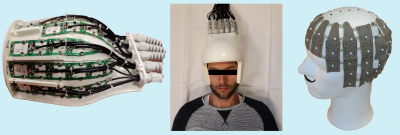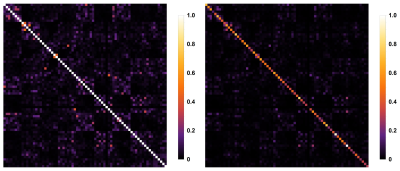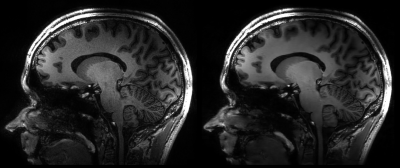1425
High-density 72-channel head array at 7Tesla
Mark Gosselink1, Tijl van der Velden1, Hans Hoogduin1, Martijn Froeling1, and Dennis W. J. Klomp1
1University Medical Center Utrecht, Utrecht, Netherlands
1University Medical Center Utrecht, Utrecht, Netherlands
Synopsis
A 64 channel head coil receiver is presented that operates with low noise coupling inside a continuously tuned 8-channel transceiver coil. When used as a 72-channel receiver the setup outperforms the default 32 channel receiver array in acceleration, demonstrated by high-resolution MPRAGE images of the human brain.
Introduction
Ultra-high field MRI becomes more accessible by the rise in the clinical grading of 7T MRI systems. The inherent gain in SNR (Signal-to-noise ratio) at higher field strengths enables high-resolution imaging, but is more time consuming and thus demands for acceleration techniques. Parallel imaging using high-density phased array coils can increase the spatiotemporal resolution while maintaining SNR by minimizing the g-factor. In this work, we show the acceleration performance of a 64-channel receiver array in combination with an 8-channel pTx transceiver head coil when compared to a similarly designed 32-channel headcoil.Methods
The coil setup consists of a high-density 64-channel head coil array (WaveTronica BV, Utrecht, Netherlands) combined with an 8-channel parallel transmit head-coil (Nova Medical, Wilmington MA, USA). A whole-body 7T MR scanner (Philips Healthcare, Best, The Netherlands) standardly equipped with 32 receive channels and 8 parallel transmit (pTx) channels was upgraded using the digital (dStream) architecture to expand the number of receivers to enable reception with all 72-channels simultaneously.In line with the 32-channel headcoil (Nova Medical, Wilmington MA, USA), the high-density receiver array consists of coil strips shaped to fit around a 3D-printed helmet, 8 strips for the 32-channel array and 16 strips for the 64 channel array (Figure 1). Each coil strip of the 64-channel array has 24 x 30 mm sized elements, which are decoupled using a predefined overlap in the axial direction. Furthermore, preamplifier decoupling has been applied for all elements by selecting the correct cable length. The interface box including 64 preamplifiers and driver boards is located at the end of the pTx head coil. The output of the preamplifiers are connected via coaxial cables to the digital receivers (ADC) located at the end of the bore.
Acceleration evaluation was performed based on acquired low flip angle 2D MS FFE scans with two dynamic acquisitions (flip angle: 10 degrees; TR = 5.5ms; 2 mm isotropic acquisition resolution; 240 x 240 x 240 cm3 field of view). Raw complex data per channel was exported for data reconstruction and processing. Data was obtained once with the 32-channel coil setup in the detunable transmitter array, and once with the 64 channel inside the similar transmitter array albeit driven continuously in tuned mode, both loaded with the same human head. Finally, high-resolution 3D MPRAGE sequence was performed using all 72 channels of the 64 channel receiver array and the 8 channels of the transceiver array (flip angle: 6 degrees; TR = 9.0 ms; 0.8 mm isotropic acquisition resolution; 250 x 250 x 200 cm3 field of view) using SENSE factor 2.5 x 2.2 and Compressed SENSE factor 5.5.
Noise correlation and noise covariance matrixes were calculated from the second dynamic noise scan data. Thereafter, 1/g-factor maps were calculated by downscaling the fully sampled k-space. The 1/g-factor maps were obtained using the coil sensitivity maps and the noise covariance matrixes according to Pruessmann et al [1].
Results
Noise correlation and noise covariance matrixes show low coupling (<0.3) between most of the local receive coils. Furthermore, in the 64 channel setup, low coupling is observed between the continuously tuned transmit elements and the high-density receiver array (Figure 2). With the 64+8=72 channel receive setup, calculated 1/g-maps show a potential acceleration up to 4 in one direction, and 4x3 (AP, LR) for two acceleration directions while remaining a 1/g-factor threshold of >0.67 (Figure 3). Compared to the 32-channel setup, this would be an acceleration of 1.7 for the same threshold, (see Figure 4 for zoomed comparison between the coil setups). When driven with 72-channels as receivers, high resolution MPRAGE could be obtained from the human brain (Figure 5).Discussion
In line with a 64-channel receiver array using fully overlapped elements in all directions [2], our increased channel counts coil setup shows substantial improvements in imaging acceleration when compared to a 32-channel array at 7Tesla. Moreover, as the transmit elements show low RF coupling to the receiver array, they can be merged as receivers to facilitate a 72-channel array. The 0.8mm isotropic resolution MPRAGE obtained in 4:35 minutes illustrates the superb performance of the setup.Conclusion
We have shown the design of a 64-channel head coil array that can be merged with an 8-channel transceiver to facilitate 72-channel simultaneous signal reception at 7T. When compared to a similarly designed 32-channel array, acceleration performance is increased. Moreover, with the 72-channel coil, excellent MPRAGE images can be obtained from the human brain.Acknowledgements
No acknowledgement found.References
[1]: Pruessmann KP, Weiger M, Scheidegger MB, Boesiger P. SENSE: Sensitivity encoding for fast MRI. Magn. Reson. Med. 1999;42:952–962 doi: 10.1002/(sici)1522-2594(199911)42:5<952::aid-mrm16>3.3.co;2-j.
[2]: Uğurbil K, Auerbach E, Moeller S, et al. Brain imaging with improved acceleration and SNR at 7 Tesla obtained with 64‐ channel receive array. Magn Reson Med. 2019;82: 495–509.
Figures

A 64-channel high-density receiver array as shown is combined with an
8-channel transmit head-coil (not shown).

Noise correlation and covariance matrixes demonstrating low coupling
between elements. Note that also the 8-channel transceiver (left upper corner)
show very low coupling to the 64 receivers.

1/g maps of the 72-channel coil for accelerations up to 25-fold (5x5)
for AP-LR, FH-AP, and LR-FH directions using all 72-receiver channels, which
includes incorporation of the transceiver elements.

1/g map
comparison of the 72-channel coil (right) to the 32 channel coil (left).

High resolution (0.8mm isotropic) MPRAGE with SENSE (left) and
Compressed SENSE (right) obtained in 4:35 min.